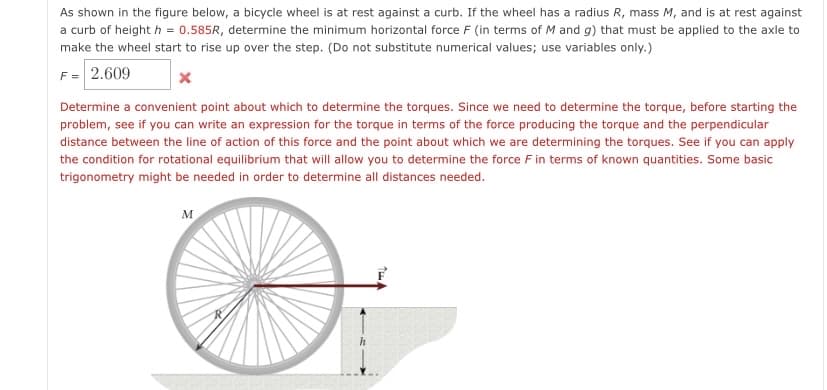As shown in the figure below, a bicycle wheel is at rest against a curb. If the wheel has a radius R, mass M, and is at rest against a curb of height h = 0.585R, determine the minimum horizontal force F (in terms of M and g) that must be applied to the axle to make the wheel start to rise up over the step. (Do not substitute numerical values; use variables only.) F= 2.609 Determine a convenient point about which to determine the torques. Since we need to determine the torque, before starting the problem, see if you can write an expression for the torque in terms of the force producing the torque and the perpendicular distance between the line of action of this force and the point about which we are determining the torques. See if you can apply the condition for rotational equilibrium that will allow you to determine the force Fin terms of known quantities. Some basic trigonometry might be needed in order to determine all distances needed. м
As shown in the figure below, a bicycle wheel is at rest against a curb. If the wheel has a radius R, mass M, and is at rest against a curb of height h = 0.585R, determine the minimum horizontal force F (in terms of M and g) that must be applied to the axle to make the wheel start to rise up over the step. (Do not substitute numerical values; use variables only.) F= 2.609 Determine a convenient point about which to determine the torques. Since we need to determine the torque, before starting the problem, see if you can write an expression for the torque in terms of the force producing the torque and the perpendicular distance between the line of action of this force and the point about which we are determining the torques. See if you can apply the condition for rotational equilibrium that will allow you to determine the force Fin terms of known quantities. Some basic trigonometry might be needed in order to determine all distances needed. м
University Physics Volume 1
18th Edition
ISBN:9781938168277
Author:William Moebs, Samuel J. Ling, Jeff Sanny
Publisher:William Moebs, Samuel J. Ling, Jeff Sanny
Chapter10: Fixed-axis Rotation
Section: Chapter Questions
Problem 47P: A man stands on a merry-go-round that is rotating at 2.5 rad/s. If the coefficient of static...
Related questions
Question
Please help me solve this problem. i got it wrong the first time. circle the answer please, thank you.

Transcribed Image Text:As shown in the figure below, a bicycle wheel is at rest against a curb. If the wheel has a radius R, mass M, and is at rest against
a curb of height h = 0.585R, determine the minimum horizontal force F (in terms of M and g) that must be applied to the axle to
make the wheel start to rise up over the step. (Do not substitute numerical values; use variables only.)
F = 2.609
Determine a convenient point about which to determine the torques. Since we need to determine the torque, before starting the
problem, see if you can write an expression for the torque in terms of the force producing the torque and the perpendicular
distance between the line of action of this force and the point about which we are determining the torques. See if you can apply
the condition for rotational equilibrium that will allow you to determine the force F in terms of known quantities. Some basic
trigonometry might be needed in order to determine all distances needed.
M
Expert Solution
This question has been solved!
Explore an expertly crafted, step-by-step solution for a thorough understanding of key concepts.
This is a popular solution!
Trending now
This is a popular solution!
Step by step
Solved in 3 steps with 3 images

Knowledge Booster
Learn more about
Need a deep-dive on the concept behind this application? Look no further. Learn more about this topic, physics and related others by exploring similar questions and additional content below.Recommended textbooks for you

University Physics Volume 1
Physics
ISBN:
9781938168277
Author:
William Moebs, Samuel J. Ling, Jeff Sanny
Publisher:
OpenStax - Rice University

University Physics Volume 1
Physics
ISBN:
9781938168277
Author:
William Moebs, Samuel J. Ling, Jeff Sanny
Publisher:
OpenStax - Rice University